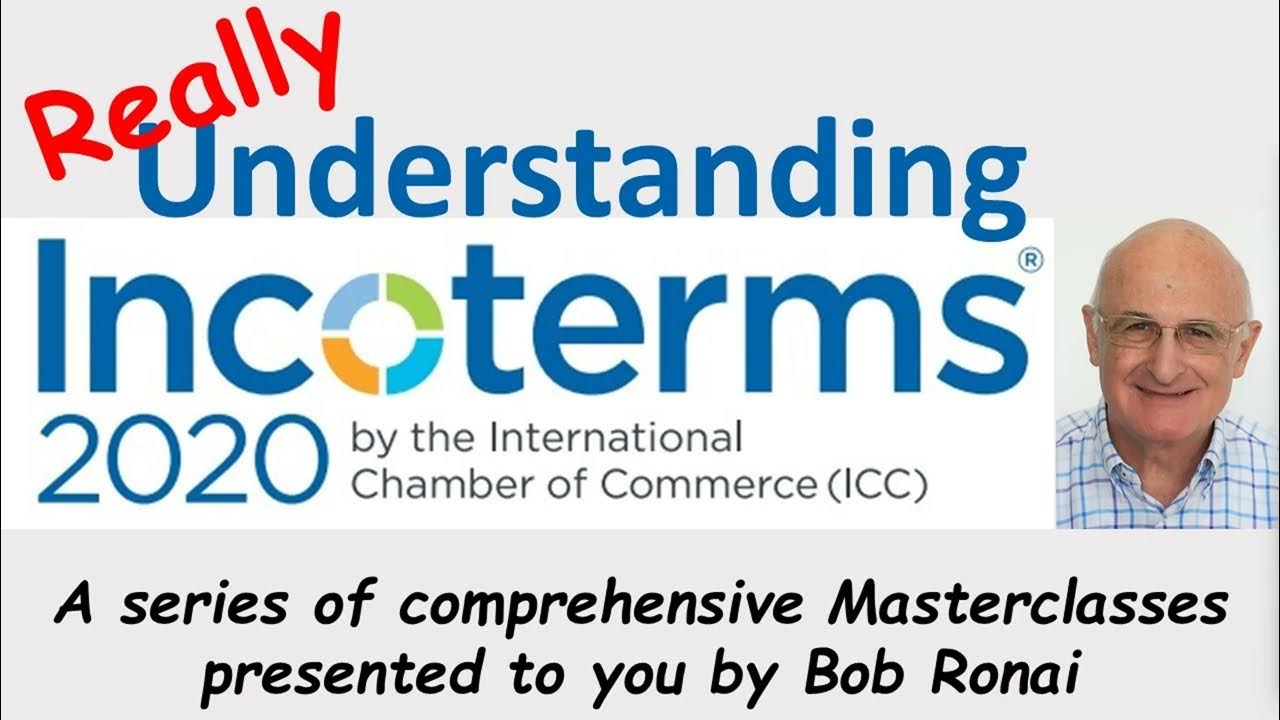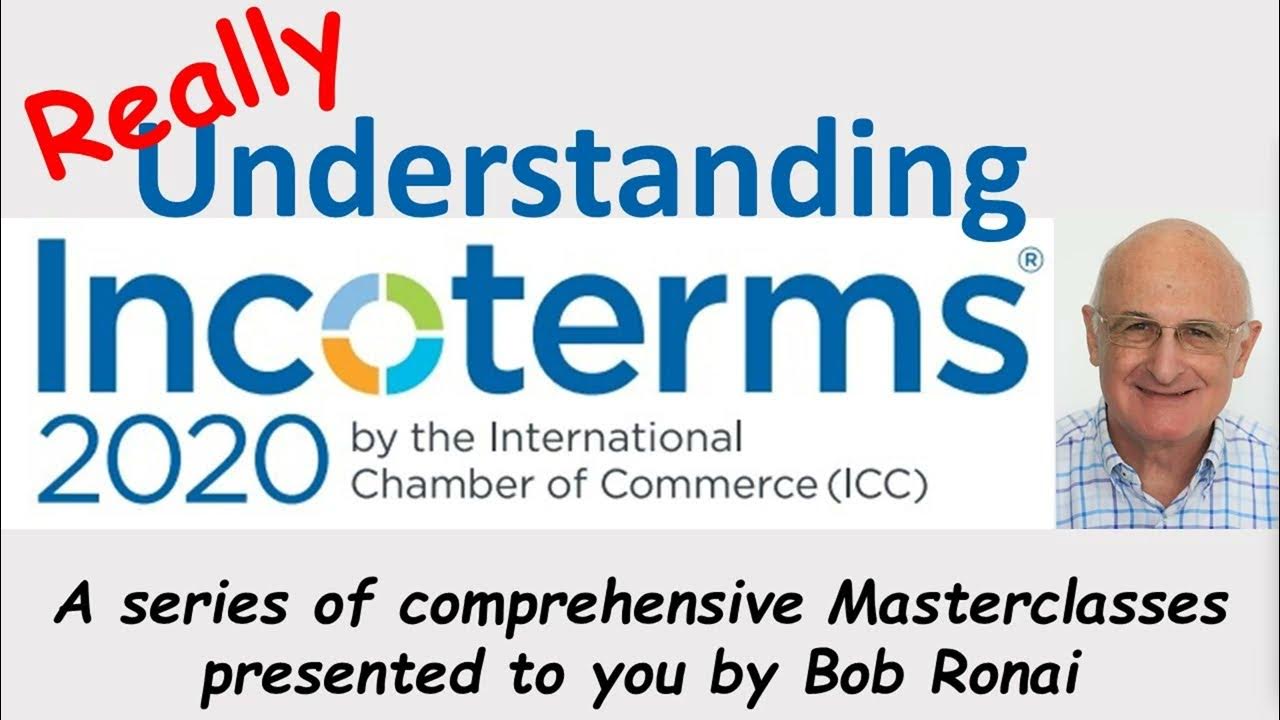Lesson 7 - CPT and CIP part 2 - more on these rules plus all about insurance in CIP, and using L/Cs
Summary
TLDRIn this master class on Incoterms 2020, Bob Ronnie continues the detailed exploration of the CPT (Carriage Paid To) and CIP (Carriage and Insurance Paid To) rules. He delves into key aspects such as delivery, notices, and insurance requirements under these terms. The video explains the seller's obligations, including providing cargo insurance and notifying the buyer of delivery, while addressing potential issues with letters of credit. Ronnie shares his extensive expertise and insights gained over five decades, offering practical advice for navigating these complex trade terms.
Takeaways
- 😀 The course is focused on explaining Incoterms 2020, specifically the rules CPT (Carriage Paid To) and CIP (Carriage and Insurance Paid To).
- 😀 Bob Ronnie, the instructor, emphasizes that he is not a lawyer and the course content is not legal advice, but based on his over five decades of experience in trade.
- 😀 The lesson highlights the importance of understanding Incoterms 2020 rules and explains the processes involved in these specific terms, including delivery and insurance requirements.
- 😀 Under the CPT and CIP rules, delivery occurs when the seller gives goods to the carrier, not when the goods arrive at the destination.
- 😀 CPT and CIP have specific rules regarding insurance, with the seller required to provide cargo insurance that covers at least the price of the goods plus 10%.
- 😀 The seller is responsible for obtaining insurance at their cost, but the buyer must provide necessary information to obtain additional insurance if requested.
- 😀 A key difference between CPT and CIP is the insurance coverage under CIP, where the seller must also insure the goods and provide evidence of the insurance to the buyer.
- 😀 The lesson discusses how CPT and CIP transactions relate to Letters of Credit (LCs), highlighting the difficulty in aligning LCs with these terms due to specific requirements for port loading and discharge.
- 😀 When working with LCs for CPT or CIP transactions, the buyer should request the bank to include the place of taking in charge and place of final destination, excluding other fields like port of loading or discharge.
- 😀 Bob Ronnie concludes by encouraging viewers to subscribe and engage with future lessons, which will cover the DAP and DDP rules in more detail, continuing the discussion on delivery and transport documents.
Q & A
What is the focus of this lesson in the series 'Really Understanding Incoterms 2020'?
-This lesson focuses on the rules of CPT (Carriage Paid To) and CIP (Carriage and Insurance Paid To), specifically discussing notices, insurance requirements, and the challenges faced in letter of credit (LC) transactions.
What is the role of the seller in relation to insurance under the CIP rule?
-Under CIP, the seller is responsible for obtaining cargo insurance at their own cost, ensuring that it meets the specified coverage requirements. The insurance must cover the price of the goods plus 10% and must be contracted with reputable underwriters.
What is the purpose of the additional 10% in the insurance coverage under CIP?
-The additional 10% in the insurance coverage is meant to cover additional costs such as port charges, import clearance, trucking, and other incidental costs, ensuring a more comprehensive coverage beyond just the invoice value of the goods.
What are the 'Institute Cargo Clauses' mentioned in the lesson?
-The 'Institute Cargo Clauses' (such as LMA, IUA) are standard cargo insurance clauses used in the shipping industry, providing 'all risks' coverage with specific exceptions. These clauses are relevant to both sea and air transport.
What is the key difference between CPT and CIP in terms of delivery?
-The key difference lies in the seller’s responsibility for insurance. While both rules involve delivery when the seller hands the goods to the carrier, CIP requires the seller to also provide insurance, unlike CPT where the seller is only responsible for transport costs.
How does the buyer's responsibility differ under CPT and CIP?
-Under both CPT and CIP, the buyer is responsible for receiving the goods at the destination. However, under CIP, the buyer also has the option to request additional insurance from the seller, which isn't the case under CPT.
What is the importance of the 'place of destination' in the context of Incoterms?
-The 'place of destination' is critical as it defines the point where the buyer takes delivery of the goods. It is essential for determining where the seller's responsibility ends and the buyer’s responsibility begins, especially in transportation and risk allocation.
What is the issue with using letters of credit (LC) in CPT and CIP transactions?
-Letters of credit (LC) generally don't align well with CPT and CIP rules because they typically require documents like an on-board transport document or bill of lading, which are issued after delivery. Since delivery occurs when the seller gives the goods to the carrier, LCs often don’t cover the actual points of responsibility.
What is the proper way to structure a letter of credit for a CPT or CIP transaction?
-For CPT and CIP transactions, the letter of credit should include only the fields for 'place of taking in charge' and 'place of final destination,' avoiding fields like 'port of loading' and 'port of discharge.' It should also require presentation of a forwarder's cargo receipt or a received-for-shipment bill of lading.
How should an insurance certificate be handled in a CIP transaction?
-In a CIP transaction, the seller should present an original insurance certificate or policy, endorsed in blank, that complies with the relevant insurance clauses (Institute Cargo Clauses A, and if applicable, war and strikes clauses). This certificate should cover at least 110% of the invoice value.
Outlines

Esta sección está disponible solo para usuarios con suscripción. Por favor, mejora tu plan para acceder a esta parte.
Mejorar ahoraMindmap

Esta sección está disponible solo para usuarios con suscripción. Por favor, mejora tu plan para acceder a esta parte.
Mejorar ahoraKeywords

Esta sección está disponible solo para usuarios con suscripción. Por favor, mejora tu plan para acceder a esta parte.
Mejorar ahoraHighlights

Esta sección está disponible solo para usuarios con suscripción. Por favor, mejora tu plan para acceder a esta parte.
Mejorar ahoraTranscripts

Esta sección está disponible solo para usuarios con suscripción. Por favor, mejora tu plan para acceder a esta parte.
Mejorar ahoraVer Más Videos Relacionados
5.0 / 5 (0 votes)






